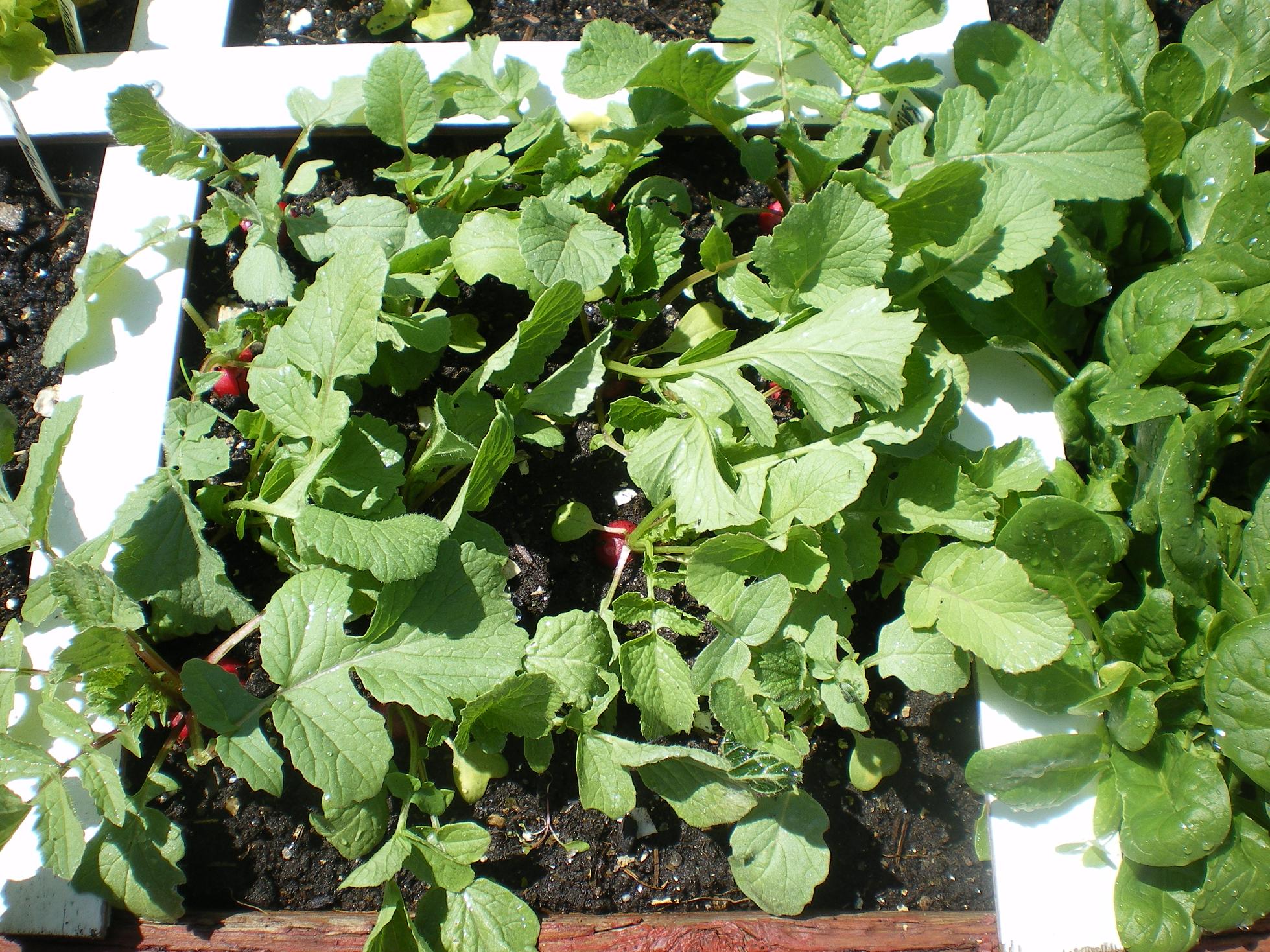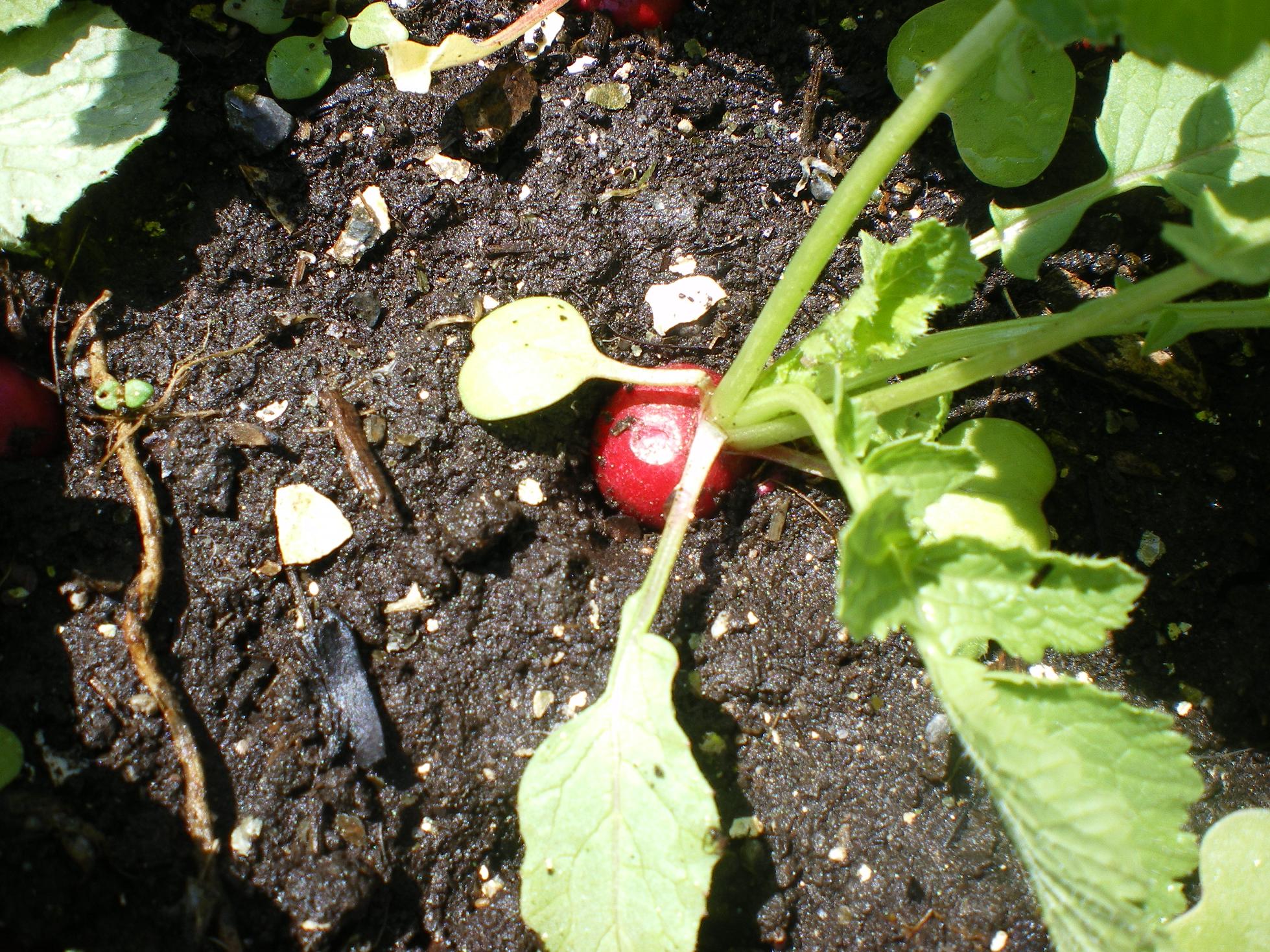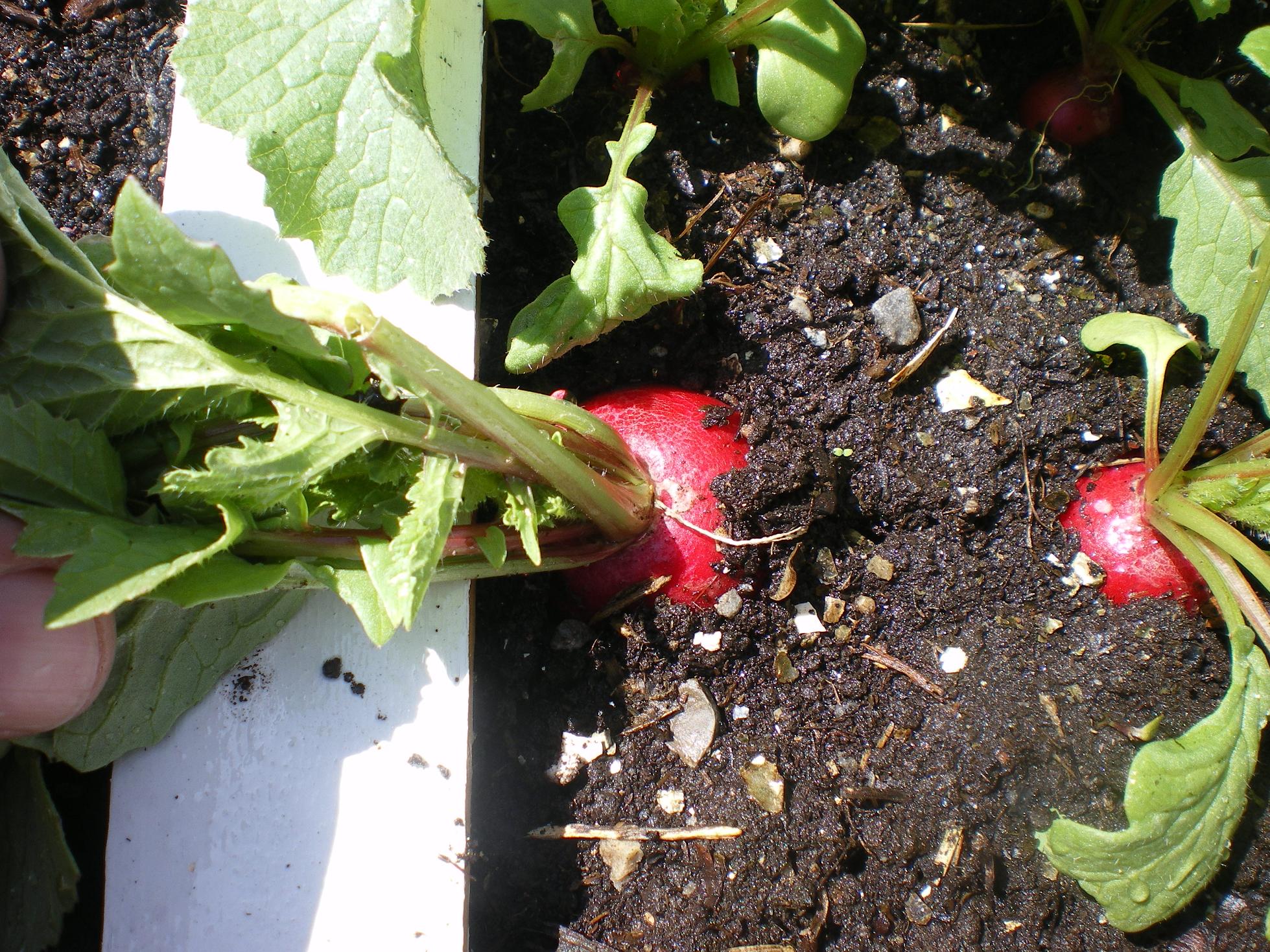

 I was surfing the internet a few weeks ago and ended up back at the square foot garden foundation website in the forum area. I don’t mean to be critical but there is some really bad advice given to other square foot gardeners. I think that poor information will lead to poor results. I’ve been following a couple of conversations-without comment-to see how some of this advice would pan out. And it’s been met with a brand new SFGer who is now frustrated because things don’t seem to be working very well. It’s difficult to sit by and watch as this develops. One of the questions this 1st year SFGer asked was:”how do you know when radishes are done?” The answer she got was: “you harvest radishes in 30 days or when the leaves are big.” That was it. So, since the radishes had been in the ground for the allotted time and also seeing big leaves, she pulled out her radishes. You should’ve seen them. The radishes were the size of skinny little pencils. This is not the way to harvest radishes in a square foot garden. I would say a beginning point is 30 days but then you have to look at them. It might be 40 days depending on water and weather. These aren’t like potatoes when you really don’t know what root crops looks like below the soil. There should be no guesses with radishes. The first picture shown is radishes-with big leaves. If I were to have pulled all of these I would’ve been disappointed. How do I know? If you look at the second picture, I’ve lightly scratched back some soil to see how big the radish is. You can see that it’s small. This was the size of the radish this new SFGer pulled out of the garden. If you look at the 3rd picture you’ll notice a different sized radish. You’ll also notice the size of the radish right next to the perfect one. Now I know I can harvest this radish and leave the others in the ground for another several days when I can look again. This square foot gardening really isn’t meant to be difficult. But because it’s do different than traditional single row gardens, some of the basic rules change. That brings me to another point. I found this really cool website a few months ago from a guy who is a homesteader. You know-basically living/growing off the land. Last year was his first attempt at a square foot garden. It looked pretty good to me. You can find him here. You’ll find all sorts of great info at his site, including this experiment he did with a square foot garden…[ois skin=”below post”]
I was surfing the internet a few weeks ago and ended up back at the square foot garden foundation website in the forum area. I don’t mean to be critical but there is some really bad advice given to other square foot gardeners. I think that poor information will lead to poor results. I’ve been following a couple of conversations-without comment-to see how some of this advice would pan out. And it’s been met with a brand new SFGer who is now frustrated because things don’t seem to be working very well. It’s difficult to sit by and watch as this develops. One of the questions this 1st year SFGer asked was:”how do you know when radishes are done?” The answer she got was: “you harvest radishes in 30 days or when the leaves are big.” That was it. So, since the radishes had been in the ground for the allotted time and also seeing big leaves, she pulled out her radishes. You should’ve seen them. The radishes were the size of skinny little pencils. This is not the way to harvest radishes in a square foot garden. I would say a beginning point is 30 days but then you have to look at them. It might be 40 days depending on water and weather. These aren’t like potatoes when you really don’t know what root crops looks like below the soil. There should be no guesses with radishes. The first picture shown is radishes-with big leaves. If I were to have pulled all of these I would’ve been disappointed. How do I know? If you look at the second picture, I’ve lightly scratched back some soil to see how big the radish is. You can see that it’s small. This was the size of the radish this new SFGer pulled out of the garden. If you look at the 3rd picture you’ll notice a different sized radish. You’ll also notice the size of the radish right next to the perfect one. Now I know I can harvest this radish and leave the others in the ground for another several days when I can look again. This square foot gardening really isn’t meant to be difficult. But because it’s do different than traditional single row gardens, some of the basic rules change. That brings me to another point. I found this really cool website a few months ago from a guy who is a homesteader. You know-basically living/growing off the land. Last year was his first attempt at a square foot garden. It looked pretty good to me. You can find him here. You’ll find all sorts of great info at his site, including this experiment he did with a square foot garden…[ois skin=”below post”]

Free seasonal SFG newsletter with tips and tricks
7-8 lbs. of potatoes per square!
Minimize the effect of inflation on your food dollars

Hey there Yus! Thanks for coming by and visiting. I’m a member of the SFG Foundation but I don’t spend much time on the forums. I’ve found it a bit confusing sometimes. Just be careful not get advice that might lead you down the wrong path. A lot of the information in the forum is good, but some of it might be questionable for new SFGers. I did an internship with Mel Bartholomew about 13 years ago. I spent about 3 months with him and I think he tried to show me everything he knows. It’s hard to constantly make suggestions to people who are always trying to short-cut something and then end up failing. You can spend a whole life making suggestions to some folks no avail. My experience is that row gardeners will not believe much of anything we teach about square foot gardening. For them, they are not going to plant things as close together as we do, and they are going to do all kinds of fertilizer amending, testing of soil, etc. For everything you want to do in a square foot garden, they are going to come up with some reason why it won’t work. Like I’ve said before, all these folks that have single row gardens-the methods to make them come from county agriculture courses and farming practices. That’s great for farming, but we are not farmers. We are home gardeners, and there’s a big difference. The difference between the two systems are quite substantial. That’s why Mel started SFG-to make it easy, even for the gardener who had no experience. I think my best advice would be to take what we refer to as the “101” class and then the “201” class. If you get the right instructor you will walk away from approximately 4 hours of training and will then not have to rely on anybody else for some of the silly answers you might get. What state are you in?
Your dead on when you say say the rules change for SFG gardening and that people often fail to realize that.
They know the system works but they don’t really understand how it works… so I have noticed a tendency for even some more experienced SFGers to think as the ANSFG book as a set of somewhat arbitrary rules….They don’t often see the that Mel made SFG the way he did for very sound reasons and that its important to keep to the method for those reasons.
The potting soil thing being a good example of that.
When your planting twice or more the number of veggies in a space as compared to other non intensive gardening methods your obviously gonna need much more in the way of soil fertility in order to be successful and avoid soil exhaustion….hence the reason Mel made his mix roughly 33% compost when many other non intensive methods only use 10% compost in .
That is why potting soil does not work..or indeed why you can’t just use any old soil for SFG gardening.
The 1/3 compost in Mel’s Mix is critical for making many of the other techniques in the book (like the intensive grid planting) work.
Thanks for listening and keep up the good work.
Its gotten real bad on the forum lately.
There has been a lot of discussion lately about weather or not potting soil mixes like Miracle Gro Garden Soil are suitable for SFG…….the consensus on the forum seems to be growing that it just fine about any old potting mix for SFG and that any potting mix will turn into Mels Mix eventually……. and any one who says otherwise is a accused of being a “purist”.
Its hard to say something without gettin beat up.
I don’t spend a lot of time in the forum only because I’ve seen some questionable advice from a few folks. If people want to use that other stuff, that’s fine. It might work for the very short-term. Just follow some of those folks who are using something other than the real Mel’s mix and see where they are in 3 months, and then again next year. My point is why change something that already works? And potting soil will not turn into Mel’s mix eventually. Anybody who knows anything about what they put into potting soil will know that. Why do you think you have to add fertilizer after 4 weeks and then continually thereafter? Those potting soil mixes are not made for the long-haul. Don’t get too frustrated with it. Find out what works and find out why it works and you’ll never have to rely on the “expert” advice from anyone else. I had one of those experts review my ebook-which was a real cheap shot on his part. Besides the fact that his “review” was inaccurate, the two points I made in the ebook are classic of what is happening on that website forum. I guess if you really want to see if I know what I’m doing, you could just read what Mel himself said about the ebook. Just stick to the basics, learn a few things every year, and you will be the expert in no time. This is an easy gardening system with some specific guidelines. Sticking to the basics will take you a long way….
I am not frustrated for myself….I am well acquainted with the internet “expert” type….its other newbies like this I worry about…
http://squarefoot.creatingforum.com/t12517-is-miracle-gro-garden-soil-ok-to-use
Its so painful to watch….
Anyway Great Book Jim…I love your blog…sorry for bothering you….just had to get that off my chest.
Wow..yes, I did see that thread and just now am realizing that was you. Yeah, I agree with you, it is painful. You just want people to have the same kind of success that you are having, and they won’t with some of the tips their getting. I’m glad you like the book. I think it’s like Mel says-it’s for experts(certified teachers will hear these things all the time)and beginners only! I laughed when he said that. Oh well, keep us updated on your SFG this year. I loved your soil analysis of Miracle Grow. I’m going to use that for my classes when I get the hecklers in the back of the room who say “you can use it-it’s ok!” Thanks for the information-that was great….Jim
Hi Jim.
Something is not clear to me. When do I use the Vermiculite in a cup to sprout things and when do I use the Pot maker with lights to sprout seeds.
I do not see which seeds I should do this with.
Thanks
Ganzalo…two things. One-you use vermiculite for things you want to sprout when you’re not sure what kind of seeds your dealing with. Say you’ve got a packet of cantalope seeds that are 5 years old. You’ve lost some degree of germination due to the age of the seeds. Instead of putting them outside or planting them in pots, you sprout them because then you will know which seeds are viable. If you didn’t do that you might plant several seeds outside, water and take care of them only to find that many didn’t germinate. When they come up in vermiculite, you then know those plants are alive and viable for future growth. You can then plant these in the pot maker and take care of them as you normally would. Two-you use the pot maker for things that you want to start early-inside-that will remain in the paper cups for 4-6 weeks. If you go longer than that you run the risk of plants getting root-bound. My tomatoes have been in the pot maker paper cups for 6 weeks and that’s about all they can take. Their root systems are starting to wrap around the soil and I don’t want them to get root bound. I also start flowers in the pot maker, along with some herbs. But for the herbs I only used them for about 3 weeks where they then went into the garden-after the hardening off process. When it gets too hot or difficult to germinate lettuce seeds in the summer, I might start lettuce seeds in the pot maker. Once their up and established, I will then put them directly in the garden. I just increased my changes of a successful lettuce harvest by doing it this way. Hope that helps….
Thanks Jim!
Thanks for the info Jim. Just getting ready to harvest some of my raddishes.